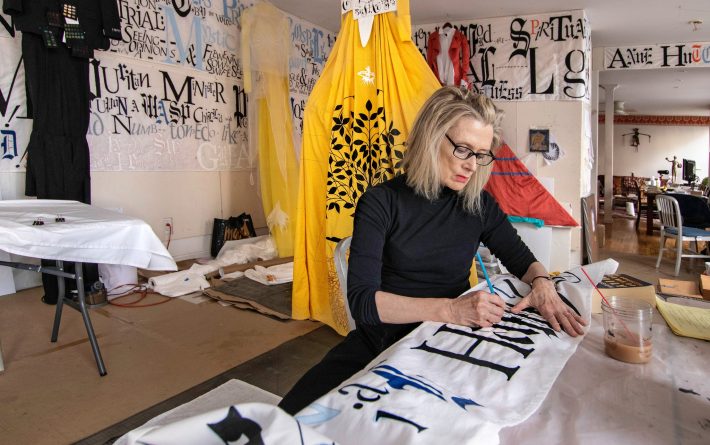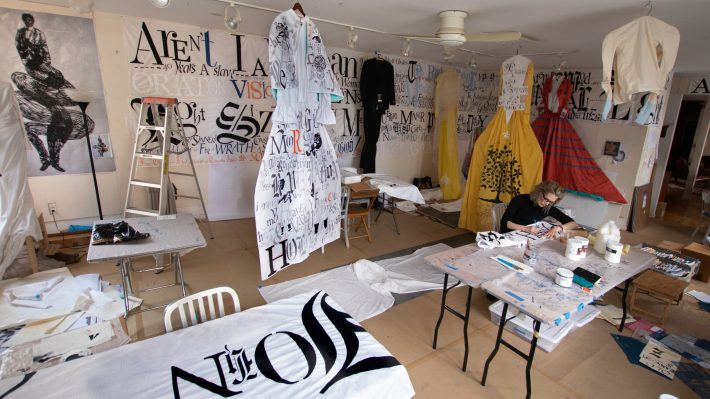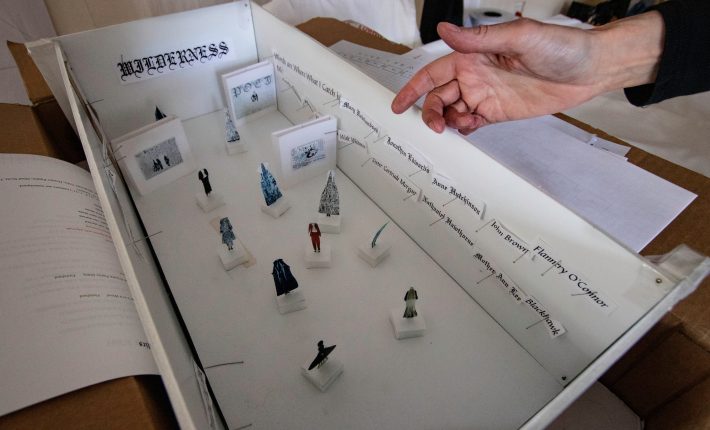Lesley Dill usually works with six to eight assistants, but now she is alone with the hundreds of yards of fabric she uses for her mixed-media art.

Lesley Dill works on a scroll for “Wilderness: Where You Come from Is Gone,” an exhibition scheduled to open next year at the Figge Art Museum in Davenport, Iowa.
Lesley Dill, a mixed-media artist who has had more than 100 solo exhibitions, works in a 300-square-foot studio in her apartment in an Art Deco tower in Downtown Brooklyn that she shares with her husband, Edward Robbins, a journalist and filmmaker.
The studio is many times smaller than the museums and galleries in which she typically exhibits her art. Sometimes her ambitions force her to spill into the kitchen. But since the coronavirus appeared and Ms. Dill, 70, had to send her half-dozen assistants home, her life has contracted.
She has been left alone with hundreds of yards of fabric scrolls on which she stencils lush quotations plucked from the 19th century. Surrounding her, too, are huge cloth figures dressed in spiky word-covered garments.
These are the components of “Wilderness: Where You Come From Is Gone,” Ms. Dill’s evolving study of divinity and deviltry in the early United States. The textile figures represent religious crusaders, social activists and Native American leaders whose voices have improbably risen from repression and exclusion. The cast includes the Puritan reformer Anne Hutchinson, the abolitionists James Brown and Sojourner Truth, the Shakers founder Mother Ann Lee, the artist Horace Pippin, the Sauk leader Black Hawk and a dozen others.
Exhibited in New York in 2018, “Wilderness” is scheduled to open in its expanded version next year, on May 29, 2021, at the Figge Art Museum in Davenport, Iowa. In late March, Ms. Dill spoke by phone about adapting to her new work style. (This interview was edited for clarity and length.)
How are you spending your days?
The space at the Figge Museum is 90 by 38 feet, with 20-foot ceilings, and my project needs to fill it. I am hoping to complete 16 3-by-12-foot scrolls that wrap the entire gallery. Plus, I’m working on five new 8-foot-high textile sculptures to add to the existing 10, plus two 8-foot-high drawings. (The existing figures are at the Nohra Haime Gallery in New York, which represents her.)
You had to say goodbye to the team of interns who normally help you paint the hundreds of thousands of letters you stencil onto your flat pieces and sculptures. How are you coping?
My wonderful right-hand studio manager, Sarah Ingber, lives only four blocks away, in Brooklyn Heights, thank God. On the last day she could come here after the ban on nonessential workers, we ordered supplies from Blick and packed up a huge suitcase for her to take home full of paint, brushes and scrolls that I had already stenciled. We also packed up a large scroll and paint for my assistant, Alannah Sears, who lives in Inwood.
Our plan is to review the work in snapshots we send back and forth on our phones. Sarah, being so close, can drop off what she has done in the lobby, and I can leave things for her to pick up. When Alannah is finished, I’m going to have her FedEx it back to me. We will let whatever we have touched or worked on breathe for two or three days in some outdoor space. Of course, I spray everything with Formula 409 anyway.

The project quotes fervent 19th-century Americans on the theme of divinity and deviltry. “I am embedded in language,” Ms. Dill said.
Image Credit: Ed Robbins
How does it feel to be working alone?
For me, this sequential stenciling of the words is a music. It’s a melody. It’s like a concerto that I’m working with in terms of how the words are large, are small, how they hook into each other, how readable and not readable they are.
Are you listening to actual music?
Yes, for the first time alone in my studio in 20 years, I have been playing Bach. His concerto in D minor with two violins makes me swoon.
What happens if the sheltering conditions persist for many more weeks and you run out of prepared things to stencil and paint?
I will have to learn how to sew with a sewing machine, so I can make the scrolls. I will have to figure out a way to make the textile figure of Horace Pippin; all the other ones are good to go.

Ms. Dill is now alone with her creations, which were sewn by Hae Min Yun, a costume designer. The figures represented behind her are the artist Horace Pippin (in black), the Shakers founder Mother Ann Lee (in yellow), the artist Sister Gertrude Morgan (in white) and the writer Flannery O’Connor (in rose).
Photo Credit: Ed Robbins
Apart from altering your process, has the pandemic led you to think differently about your art?
My theme is the theme of the original European-American settlers and their almost biblical sense of wilderness as a fear of the unknown. It was a place of the devil, where dangers — whether from Native Americans, wild animals or starvation — lay to be conquered, to be controlled. (Native Americans did not think of the wilderness as wild; for them, the white Europeans were the devil.)
In that sense, this virus is that wilderness beast, the invisible unknown. It is the outside force that drives us to think about it, to fear it, to think about our lives differently. And somewhat like both our early European-Americans and Native American peoples, I think we will emerge from this experience into a new land — one we will try to shape into what is familiar, but also one we don’t know yet what meaning it will have globally.
You are in contact with contemporary Native Americans for this project. Has the subject of the virus — obviously a sensitive one, given the terrible history of Indians and infectious disease — come up?
It is just starting to. I’m in touch with Johnathan Buffalo, the historic preservation director of the Meskwaki Nation’s tribal museum in Iowa, and Ray A. Young Bear, who is the Native American author of the novel “Black Eagle Child.” Ray A. Young Bear passed along the words to me of a fellow tribesman: “Now you know how we felt when our predecessors were infected purposely with disease.”
What else feels relevant to this moment from your cohort of early American firebrands and justice-seekers?
The controls and the restrictions that we find in the Shakers: They walked one by one on the simple path; they didn’t walk side by side. Walking the narrow path is something we’re doing now.
You have described yourself in interviews as an introvert. Is your personality helping you in these isolating times?
Yes. I feel a sense of balance, because the deep introversion that I normally feel — the refuge, the prison, the palace of my art-making, of my heart and my mind — somehow feels matched by the quiet, the silence and the renunciation and isolation of the world right now outside my windows, in the streets.
And I find this is true of others. My friend Barbara Takenaga is single, happily working alone in her studio with her dog, Andy, today. Another friend, Charles LeDray, is upstate with his husband, but he is never happier than talking on the phone and working on his incredibly obsessive work.
Handwork, that’s what it’s about. It’s about the obsession of the mind being turned into tactile voice.
So even facing a crushing deadline, you’re not feeling so bad.
I would like to be the first to admit that, as an artist, I am lucky compared to many, many people: our health workers, the M.T.A. workers, the homeless, the at-risk families in New York.
I get to be safe in my studio. My deadline is not for another year. I can get lots of people to help me in the last month to try to make up for this, hopefully. I’m looking on this virus globally, as if the world is a big horse and this big horse is sick.
The poetry of Emily Dickinson, another famous introvert, has re-emerged in your work over the last 30 years, even supplying the content for your opera, “Divide Light,” which was restaged last year by the New Camerata Opera company and will be projected on the walls of the Figge. Which of her words come to mind now?
Emily Dickinson wrote “Some, Too Fragile for Winter Winds.” I think that’s a feeling that we feel now. And who are the fragile people? It’s still unknown.

